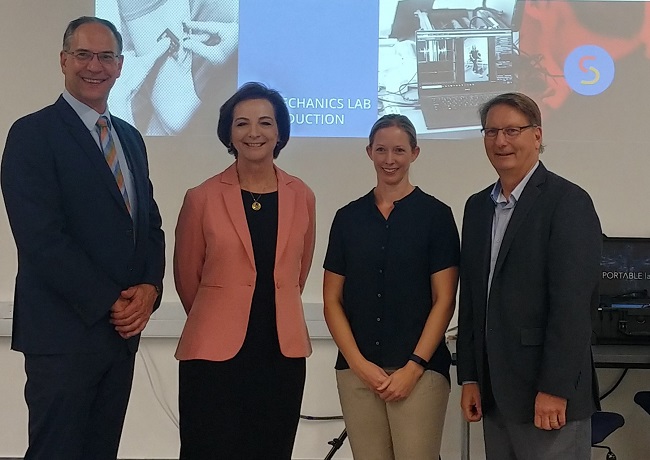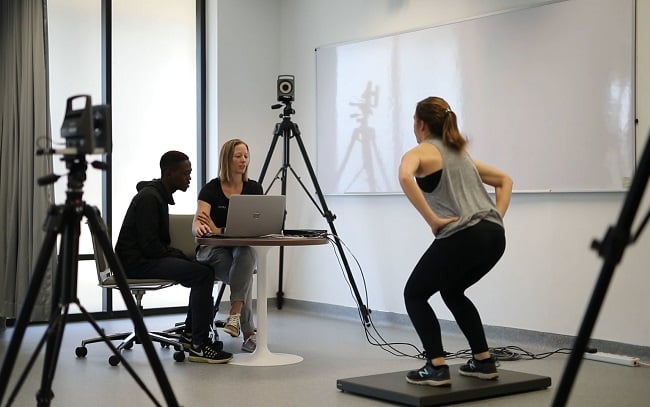Posted on October 18, 2019
The University of Pretoria’s (UP) Sport, Exercise Medicine and Lifestyle Institute (SEMLI) recently opened the doors to its new Biomechanics Lab, which is already providing support services to TuksSport’s first teams as well as elite track and field athletes, some of whom participated in the recent World Championships.
Biomechanics as a core sub-discipline of sport science is the study of human movement in order to minimise the risk of injury and improve the performance of sportspeople.
“One of the main objectives of the lab is to offer biomechanical analysis to anyone who wants to perform to their maximum capacity in their chosen sport, while minimising injuries,” explains Dr Helen Bayne, head of the lab. The new facility will also enable translational research that informs the practice of coaching, exercise training, and the prevention and management of injuries.

From left to right: Prof Tiaan de Jager (Dean of the Faculty of Health Sciences), Prof Stephanie Burton (Vice-Principal for Research and Postgraduate Education), Dr Helen Bayne and Prof Martin Schwellnus (Director of SEMLI) at the opening of the Biomechanics Lab.
“The assessment of biomechanics ranges from basic descriptions of motion to complex analyses of forces and torques produced at specific joints,” Dr Bayne adds. “This information can be used to guide coaching, conditioning or therapeutic interventions to improve performance, reduce injury risk and enhance rehabilitation.” A wide range of tools is used to provide this information, including high-speed video cameras, 3D motion-capture systems, electromyography, radar guns, force plates and inertial measurement units.
While this sort of support system for athletes is a standard facility abroad, it is rarely found in South Africa. The Biomechanics Lab, which forms part of SEMLI’s Sport Science unit, is a world-class facility that puts SEMLI in a position to compete with international high-performance institutes. SEMLI’s integrated approach to research, teaching and services is what sets the institute apart; the lab is a valuable addition to its comprehensive set of multidisciplinary services.

Biomechanics as a core sub-discipline of sport science is the study of human movement in order to minimise the risk of injury and improve the performance of sportspeople.
The introduction of the lab not only strengthens the undergraduate sport science curriculum, but also opens many new doors for postgraduate studies. “The biomechanical theory that is taught in undergraduate degrees underlies the applications that will run in the lab,” says Dr Bayne. “The students will be able to experience practical demonstrations of the topics they learn about, getting hands-on experience with the tools and analyses to apply their knowledge.”
The facility provides a space for sport science postgraduates to pursue specialist studies in biomechanics and enables applied sport scientists to put biomechanics into practice. Some of SEMLI’s current research is looking into how footwear can affect running mechanics; cycling biomechanics and knee pain; and improving running with strength, speed and power.
“We hope the Biomechanics Lab will contribute to a range of disciplines in not only the Sport Science and Health Sciences fields, but across other faculties too,” says Dr Bayne.

The Biomechanics Lab is a world-class facility that puts SEMLI in a position to compete with international high-performance institutes.
Plans are also in place for biomechanics services to be made available to the public in the near future. Some of these services include a 3D gait analysis, which allows for the assessment of runners’ movement patterns related to injury; a dynamic bike for cyclists that uses 3D motion-capture technology; and a testing package for maximum strength and power, which has implications on performance across a variety of sports. “We will also implement procedures to monitor and assess progress after injury or surgery to improve the return-to-sport process.”
Copyright © University of Pretoria 2025. All rights reserved.
Get Social With Us
Download the UP Mobile App